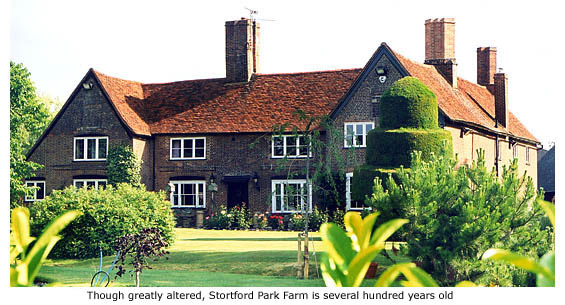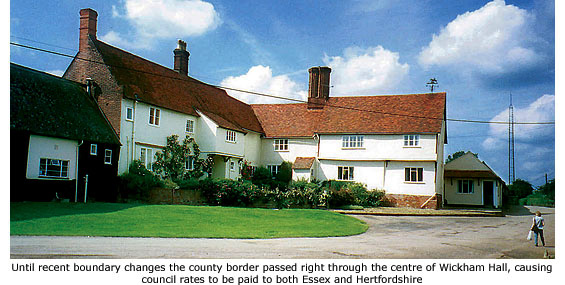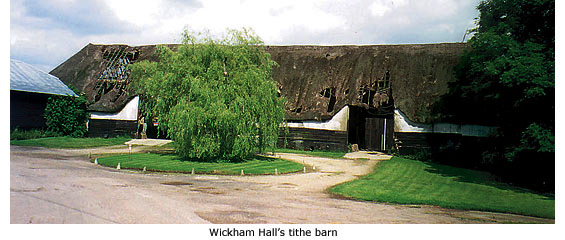|

In the 1990s, as part of the ongoing housing development at Thorley, two large areas of land were named Bishop’s Park and Stortford Park – both taking their name, like so many new developments do, from local history. In the 13th century this land formed a part of the estate of the Bishop of London's deer park, and was very likely the site of the original Bishop’s Lodge or Hall of Stortford.
The park, used for hunting, covered a vast area, stretching west from present-day Bishop's Stortford College almost as far as Cradle End (near the Tesco roundabout), and south to the outer limits of the medieval town, which was then Maple Cross (junction of London Road and South Mill Road). Here the park was on both sides of the present A1184, and its northern boundary was the road joining Stortford with Little Hadham – now the A1250 and the A120.
In the mid 20th century, long before Bishops Park Way was constructed, a raised area of land between the Hadham Road (A120) and the Great Hadham Road (B1104), east of Bury Green, became the subject of an archaeological dig. Findings revealed many animal bones and domestic items dated between the 13th and 16th century, and that the mound had been created by earth dug out to form a defensive ditch or moat around its outer edge. More importantly, the dig revealed the outline plan of a medieval building, most likely to have been a manor house that was either pulled down or left derelict in the 16th century.
This coincided with historical evidence that Bishop Fitzjames, bishop of London from 1511–1522, had pulled down the old dining hall at Bishop’s Stortford early in the 16th century. The reason for its destruction is unknown, but it was probably after this event that Rectory Manor House became the ‘official’ manor house of Stortford – itself later pulled down and replaced by the present building in the late 1500s (See Guide 10).
The replacement for the original hall, or lodge, was Stortford Park Farm, which, though now greatly altered, still exists and stands a short distance north-east of the archaeological find. It occupied an isolated spot here for about 400 years, but in the 1980s most of the farmland was sold off for housing development and the construction of Bishops Park Way, which now gives access to the farm.
First owned by the Bishop of London and held on lease by the Precentor of St Paul’s, the tithes of the farm were made out to the vicarage. A deed, related to Rectory Manor and dated 1649, describes it as part of the manor’s demesne: ‘a farme called the Parke consisting of a hall, parlour, a kitchen, a milkhouse, a buttery with four chambers over them and several old thatched barns and stables’. It was estimated at 3 acres and worth £6.10s. 0d. (£6. 50) per annum.
|
|

Wickham Hall lies to the north-west of Bishop’s Stortford and is reached by a private road running northwards from the Hadham Road. Named Wickeham and recorded as a manor in Domesday Book, the original Hall on this site was first the property of the Bishop of London. It wasn’t noted again until 1491 when Sir William Say was the owner and, that same year, conveyed his ‘plot called Wykeham Hall’, along with other lands in Bishop’s Stortford and Farnham, to one Henry Freshwater for a period of 12 years.
The property then descended by inheritance, eventually coming to Gertrude Blount, only child of the fourth Lord Mountjoy and wife of Henry Courtenay, Marquess of Exeter – a descendent of Edward IV. He was also a large landowner in Devon, but his extensive estates were confiscated at the time of the Reformation when Henry VIII accused him of being a Papist traitor and imprisoned him in the Tower of London. He was executed for treason in 1539. Whether or not Gertrude lived at Wickham Hall before or after his death is unclear but it is recorded she died a natural death in 1558.
Following the Dissolution of the Chantries, two King’s commissioners were sent to Bishop’s Stortford in 1544 to assess the wealth of St Michael’s church. One of them, Henry Parker (later to become Sir Henry Parker, Lord Morley), was then granted Wickham Hall along with the farm and other land at Thorley by Henry VIII. But he sold the property soon after and by 1560 it was in the hands of one William Goodwyn. At a later date the estate then became separated from Wickham Hall itself, because in 1633 the farm was owned by James Gibbe who sold it that same year to the owner of Hadham Hall, Arthur Capel. At the same time, Capel acquired the manor of Wickham Hall from Edward Atkins and subsequently turned the house (Wickham Hall) into a keeper’s lodge.
However, by the late 1700s it would seem Wickham Hall had reverted back to being a farmhouse under the tenure of the Stacey family – records of their harvest dates from the 1850s still in existence. Eventually, though, the entire estate, along with Little Hadham, descended to George Devereux de Vere Capel, seventh Earl of Essex who, in 1900, sold the farm to Mr Frank Stacey as a small residential estate.
Mr Stacey, one of four farmer brothers, was a keen hunter, race horse owner and well known cattle breeder, and before the Second World War allowed the once popular sport of greyhound coursing to take place at Wickham Hall. When he died in 1932, his wish to be buried in nearby Farnham churchyard was fulfilled and, in traditional manner, his hunter was led behind the coffin with Frank’s boots tied back to front. His grave can still be found just inside the churchyard gate.
The farm was then bought at auction by Stacey’s long-term friend, Frank Harvey senior, who was later joined in business by Frank Harvey junior – the former being the uncle of the latter.
The abandonment of the Point-to-Point at Brent Pelham during the war years led Frank junior’s friend and fellow farmer, Tom Streeter, to suggest that Wickham Hall would be a likely site for a new course after the war. Frank junior took up the suggestion and was responsible for the Point-to-Point course being held at Wickham Hall from 1946-1970 inclusive.
After Frank Harvey senior died in 1954, aged 80, the business was continued by Frank Harvey junior, who two years later was joined in partnership by his son, Ted Harvey. That partnership lasted until Frank junior’s death in the mid 1980s, after which Ted Harvey was joined by his son, David.
Ted Harvey continued Wickham Hall’s equinal association, breeding and training racehorses and point-to-pointers. His crowning glory as a racehorse owner came in 1989 when his horse, Little Polveir, won the Grand National at Aintree. In 2002 he moved to nearby Upwick Hall and it is his son, David, who currently lives at Wickham Hall and farms the associated 135 acres (1546 Hectares) of land.
The present Wickham Hall was probably built in the early 17th century, but since that time has undergone a great deal of restoration and alteration. Timber-framed and plastered, it has two storeys and attic rooms and is built on an ‘L’ shaped plan. Now, it is probably only the rear of the house that resembles the original construction. An extremely large tithe barn is a prominent feature adjacent to the house.

|

